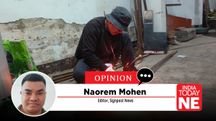A Symphony of Nature and Innovation: The Vision for Zubeen Khetra
Zubeen Khetra project aims to combine nature with technology for sustainable urban growth. It emphasises green spaces, renewable energy, and community participation to create an eco-friendly living environment

Imagine a place where the morning raga blends seamlessly with birdsong, where centuries-old folk traditions inspire cutting-edge digital compositions, and where a student from Tokyo collaborates with a master musician from Assam beneath the canopy of a thriving forest. This is not a fantasy; this is the vision for Zubeen Khetra, a world-class musical zone that could redefine how we think about music education, cultural preservation, and sustainable urban development.
In an era where cities compete to become cultural capitals and educational institutions struggle to remain relevant in a rapidly changing world, Zubeen Khetra presents a bold proposition: what if we created a place where music isn't just taught or performed, but lived, breathed, and nurtured in harmony with nature itself?
The Heart: A Global Music University Like No Other
At the centre of this vision beats the heart of Zubeen Music University, an institution designed not merely to compete with the world's great conservatories, but to complement them with something they cannot offer — a unique fusion of South Asian musical heritage, ecological consciousness, and technological innovation.
This is not about creating another Berklee or Juilliard in South Asia. Those institutions already exist and excel at what they do. Instead, Zubeen Music University would carve out a distinctive identity as the world's first major music institution built around the concept of acoustic ecology — where the study of music is inseparable from the study of natural soundscapes, where composition students draw as much inspiration from forest ambience as from Mozart, and where the preservation of birdsong is considered as important as the preservation of ragas.
The academic programs would span the full spectrum of musical expression: classical Indian and Western performance, jazz and contemporary music, traditional folk preservation, music production and engineering, ethnomusicology, music therapy, and music business. But what would make it truly distinctive is the integration of acoustic ecology throughout the curriculum, partnerships with the world's leading institutions, and a commitment to making music education accessible rather than elite.
The Soul: A Mini Forest That Sings
Adjacent to the university campus, a carefully cultivated mini forest would serve as both an ecological sanctuary and living laboratory. This wouldn't be mere decoration or greenwashing; it would be central to the institution's identity and pedagogy.
Native species selected specifically to attract songbirds would create a year-round natural symphony. Students in composition classes would study the patterns and structures of birdsong, learning how nature itself creates music through evolution. Recording studios nestled among the trees would offer unique opportunities for immersive sound experiences that no urban facility could replicate.
The forest would feature winding silent paths for acoustic meditation, natural amphitheaters carved into the landscape for intimate performances under the stars, and listening stations where visitors could simply sit and absorb the soundscape. Water features would be designed for their acoustic properties — streams that babble in rhythmic patterns, fountains that create natural percussion.
This integration of nature and music addresses something profound that modern urban life has lost: our connection to the natural world as a source of creativity and wellbeing. In Zubeen Khetra, you wouldn't escape to nature from the demands of musical training — nature would be your teacher.
The Body: Infrastructure for World-Class Music
A vision means nothing without the infrastructure to support it. Zubeen Khetra would require a comprehensive ecosystem of facilities that rival anything found in Vienna, Nashville, or London.
The centerpiece would be a state-of-the-art concert hall with variable acoustics, capable of adapting from the clarity needed for chamber music to the warmth required for romantic symphonies. An outdoor amphitheater would accommodate larger festivals and popular music events, its natural bowl acoustics enhanced by thoughtful design. Multiple recording studios would range from vintage analog facilities to cutting-edge digital production suites.
But beyond these expected elements, Zubeen Khetra would innovate. Imagine practice rooms that incorporate natural light and views of the forest, reducing the claustrophobia that makes traditional practice rooms feel like cells. Picture a music museum that doesn't just display instruments behind glass, but invites interaction and understanding. Envision rehearsal spaces designed with the same acoustic care typically reserved only for performance halls.
The infrastructure would extend beyond the university into a broader musical district. Instrument makers would have workshops where visitors could watch sitars, violins, and traditional drums being crafted by hand. Sound engineering co-working spaces would foster collaboration among freelance professionals. Music therapy clinics would serve the broader community. A music-themed boutique hotel would allow visiting artists and music tourists to fully immerse themselves in the zone's creative atmosphere.
The Network: Global Partnerships That Matter
No institution exists in isolation, and Zubeen Music University's global partnerships would be crucial to its success and reputation. But these partnerships must be strategic, mutually beneficial, and authentic — not just names on a website.
The partnership strategy would operate on multiple tiers.
Elite conservatories like Berklee College of Music, the Royal Academy of Music, and Tokyo University of the Arts would offer dual degree programs and faculty exchanges. Students could spend two years at Zubeen and two at a partner institution, graduating with degrees from both and gaining truly bicultural expertise.
Technology partnerships with companies like Yamaha, Avid, and Native Instruments would ensure students learn on industry-standard equipment and receive certifications valued worldwide. These wouldn't be superficial sponsorships — they would involve curriculum development, research collaboration, and genuine knowledge exchange.
Cultural organizations including UNESCO, the British Council, and various national cultural institutes would facilitate international exchanges, provide funding for preservation projects, and help position Zubeen Khetra as a center for cultural diplomacy through music.
Industry partnerships with major labels, streaming platforms, and music festivals would create pathways from education to employment. Universal Music Group, Sony, and Warner could scout talent at the university, offer internships, and provide real-world experience. Spotify and Apple Music could partner on data analytics research and artist development programs.
What would Zubeen bring to these partnerships? Access to South Asia's massive and growing music market, expertise in traditional music forms increasingly sought after globally, a unique acoustic ecology program found nowhere else, and a cost-effective destination for collaboration. The university wouldn't be a supplicant seeking validation from Western institutions — it would be an equal partner offering distinctive value.
The Community: Culture That Lives and Breathes
Infrastructure and partnerships matter, but culture emerges from human activity. Zubeen Khetra would pulse with a year-round calendar of festivals, performances, workshops, and community events that make music accessible to everyone, not just university students and paying tourists.
Spring would bring an International Folk Music Festival celebrating traditional instruments and oral traditions from around the world. Summer would feature youth music camps and outdoor concert series. The monsoon season would shift focus indoors with chamber music and songwriter workshops. Autumn would host an Electronic Music and Technology Summit exploring the cutting edge of sonic innovation. Winter would offer a classical music season culminating in a global New Year's celebration.
Artist residencies would bring established and emerging musicians for extended stays, during which they would create new work, teach masterclasses, and collaborate with local artists. These residencies would be prestigious enough to attract world-class talent but also accessible to promising unknowns who need time and space to develop.
Community engagement programs would ensure Zubeen Khetra serves local residents, not just international visitors. Free weekly concerts in public spaces, school partnership programs bringing children to performances, music therapy programs for seniors, and open-enrollment community choirs and orchestras would weave music into the fabric of everyday life.
The public spaces themselves would be designed for spontaneous musical encounters. Pedestrian zones would feature acoustic design that allows street musicians to perform without overwhelming conversation. Interactive musical sculptures would invite play. "Music streets" with embedded speakers could create ambient soundscapes that change throughout the day. Projection mapping could transform buildings into canvases during festivals.
The Innovation: Technology in Service of Art
While Zubeen Khetra would honor tradition, it must also embrace innovation. Music technology isn't separate from music — it's transforming what music can be and how it's created, distributed, and experienced.
The university would host specialized innovation labs focused on AI and music composition, spatial audio and immersive sound, music accessibility technology, and digital instrument design. These wouldn't be isolated research projects but integrated into the broader curriculum, ensuring all students gain literacy in music technology regardless of their primary focus.
High-speed internet throughout the zone would enable live streaming from all venues, making performances accessible globally. Augmented reality experiences could overlay historical information onto the physical environment, allowing visitors to experience musical heritage in immersive ways. A mobile app would help visitors discover events, navigate the zone, and even participate in interactive musical installations.
But technology would always serve human creativity, not replace it. The goal isn't to create a dystopian smart city obsessed with efficiency, but to use technology thoughtfully to enhance artistic expression, preserve cultural heritage, and make music more accessible.
The Economics: Sustainable and Inclusive
None of this matters if it's not economically sustainable or if it becomes an elite enclave isolated from the broader community. Zubeen Khetra must be designed from the beginning to be financially viable and socially inclusive.
The music university would generate revenue through tuition, but not at levels that exclude talented students from modest backgrounds. Extensive scholarship programs funded by partnerships, government support, and philanthropy would ensure access. International students paying full tuition would cross-subsidize local students on scholarship.
The broader musical district would create a self-sustaining ecosystem. Music businesses — instrument makers, recording studios, music publishers, artist management agencies — would pay rent and taxes that support public infrastructure. Tourism would generate revenue through hotel stays, restaurant meals, and ticket sales. Festivals could be structured with both free community events and premium ticketed performances.
Tax incentives for music businesses, affordable live-work spaces for musicians, and support for music startups would ensure the zone serves working artists, not just corporations and tourists. Living wage commitments would prevent the economic exploitation too common in creative industries.
The goal isn't gentrification disguised as cultural development, but genuine economic opportunity that lifts up the existing community while attracting new talent and investment.
The Roadmap: From Vision to Reality
Transforming this vision into reality requires a phased approach spanning a decade or more.
Phase One (Years 1–3): Foundation
Establish the music university with initial facilities and faculty. Plant the mini forest and begin ecological restoration — trees take time to grow, so this must start immediately. Build the main concert hall and primary recording studios. Launch a flagship festival to announce Zubeen Khetra's arrival on the global stage. Secure initial partnerships with 3–5 key institutions and organizations.
Phase Two (Years 4–6): Expansion
Complete public space improvements throughout the zone. Open the music business district with its workshops and co-working spaces. Develop the outdoor amphitheater. Launch full residency programs and expand academic offerings. Build the partnership network to 15–20 institutions. Achieve first significant international recognition.
Phase Three (Years 7–10): Maturation
Expand university programs based on demand and success. Achieve recognition as a top-tier international music institution. Complete technology infrastructure buildout. Develop a self-sustaining music economy that generates quality employment. Host major international conferences and festivals. Begin influencing global conversations about music education and cultural preservation.
Throughout this process, community input would be essential. This cannot be a vision imposed from above but must emerge from genuine dialogue with existing residents, local musicians, cultural leaders, and other stakeholders. Their knowledge and needs must shape the plan at every stage.
The Meaning: Why This Matters
Some will ask: why invest in music when there are more pressing needs? This question contains a false choice. Music isn't a frivolous luxury — it's central to human culture, identity, and wellbeing. It creates economic opportunity, preserves heritage, brings communities together, and offers young people pathways to meaningful careers.
Zubeen Khetra matters because it would demonstrate a different model of development, one that doesn't treat culture as an afterthought or nature as something to be conquered, but integrates them from the beginning. It matters because South Asia deserves world-class institutions that don't simply copy Western models but forge their own path. It matters because in an increasingly digital and divided world, we need more spaces where people can gather around shared creative experiences.
Most of all, it matters because music matters. The songs we sing, the instruments we play, the rhythms we dance to — these aren't decorations on life but life itself. A civilization is known by what it values enough to preserve and nurture.
Zubeen Khetra would be a statement of values: that art matters, that nature matters, that education matters, that community matters.
The Call: Making It Happen
Visions remain dreams until someone commits to making them real. Transforming Zubeen Khetra into a world-class musical zone will require leadership, funding, expertise, and sustained effort from multiple stakeholders.
Government at national, state, and local levels must commit policy support, infrastructure investment, and long-term vision beyond electoral cycles. Philanthropists and cultural foundations must see this as worthy of major support. Educational institutions must be willing to partner authentically. Musicians and artists must be willing to take risks on an unproven venture.
Local communities must embrace the transformation while ensuring it serves their needs.
The obstacles are real: funding constraints, bureaucratic challenges, competition for talent, the difficulty of achieving excellence in multiple domains simultaneously. But the potential rewards — a thriving cultural institution, sustainable economic development, environmental restoration, community transformation, and global influence — justify the risks.
What Zubeen Khetra needs now is champions willing to fight for this vision, refine it through dialogue, and begin taking the concrete
steps toward making it real. The first tree planted in the mini forest, the first partnership agreement signed, the first faculty member hired — these small beginnings can grow into something remarkable.
The question is not whether it's possible — it clearly is. The question is whether we have the collective will to create something that will resonate for generations.
In a world that often feels fragmented and disconnected, Zubeen Khetra could become a place where music brings us together, where nature and innovation coexist, where tradition and progress dance in harmony. That's a vision worth singing about.
And more importantly, it's a vision worth building.
Copyright©2025 Living Media India Limited. For reprint rights: Syndications Today









